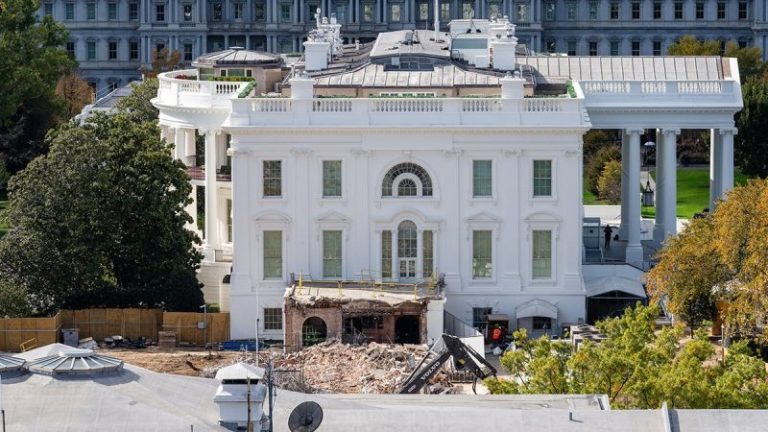House Republicans are scrambling to find a solution to sky-high health costs as the clock ticks on Obamacare tax credits that were enhanced during the COVID-19 pandemic.
House GOP leaders have been busy working with different factions within their conference this week to shape the contours of a package aimed at lowering healthcare costs for Americans, but it’s not clear if there is yet consensus on legislation that could get support from all 220 Republican lawmakers — and those in the Senate.
Speaker Mike Johnson, R-La., told Bloomberg News on Thursday that the House would vote on a healthcare plan by the end of this month.
House Majority Leader Steve Scalise, R-La., was less certain of a specific timeline, however, telling reporters, ‘We are meeting with all of our caucuses and building a coalition. And so when we’re ready to go, we will.’
‘But the focus has always been, you know, bills that will lower costs and give families options to help them, so they’re not trapped in the unaffordable care act,’ Scalise said.
He was referring to the Obama administration-era Affordable Care Act (ACA), colloquially known as Obamacare. Republicans have long criticized it as a broken system that’s served to fuel inflationary health insurance premium costs, but finding a solution that’s palatable to both Americans and officials in Washington has long eluded the GOP.
Democrats in Congress voted twice to expand Obamacare during the COVID-19 pandemic in order to get more Americans healthcare coverage. That expansion is set to run out by the end of 2025, and Democrats claim that it will push Americans’ healthcare costs sky-high if the enhanced subsidies are allowed to expire.
It’s also been a concern for a handful of Republicans, many of whom represent battleground districts that were critical to the GOP winning and keeping the House majority.
Multiple bipartisan initiatives have been unveiled in recent weeks aimed at stopping that healthcare cliff from coming. Reps. Tom Suozzi, D-N.Y., and Brian Fitzpatrick, R-Pa., are planning to release legislation expanding the enhanced Obamacare subsidies for two years, albeit with reforms aimed at streamlining the system for those who need it most.
Fitzpatrick told Fox News Digital that legislation could come out as soon as Thursday.
Meanwhile, a group of 20 Democrats and 15 Republicans led by Reps. Jen Kiggans, R-Va., and Josh Gottheimer, D-N.J., released a framework on Thursday morning that would expand a version of the enhanced Obamacare subsidies for a year, followed by a modified health plan the following year that would include ‘continued health insurance premium savings’ with ‘more significant reforms.’
The extension would reform the system with new ‘guardrails’ aimed at rooting out fraudulent actors and inactive enrollees, along with new income requirements to qualify.
‘It proposes a short-term and longer-term fix. But the bottom line is in just a few days, for millions and millions of Americans, their health insurance premiums are going to spike significantly,’ Gottheimer told reporters.
Rep. Mike Lawler, R-N.Y., a part of that group, said, ‘The extension of the Affordable Care Act subsidy with reforms is something we all agree is necessary, and then have a much longer-term discussion about how we actually fix healthcare costs in America.’
Kiggans told Fox News Digital in a brief interview that allowing the enhanced subsidies to just expire would hike costs for millions of Americans who Republicans tried to help make life more affordable for with President Donald Trump’s One Big, Beautiful Bill Act.
She said she understood and agreed with the notion of needing to phase out COVID-19-era tax programs but added, ‘We are facing a deadline with this one where, unfortunately, if we just cold turkey let those premium tax credits expire, we’re going to see spikes worth thousands of dollars.’
But conservatives within the House GOP have signaled heavy opposition to extending the enhanced Obamacare subsidies, arguing it would do little to lower healthcare costs.
‘I don’t know why Republicans, or people who consider themselves to be conservative, would give tacit approval and support of Obamacare by expanding subsidies of Obamacare,’ House Budget Committee Chairman Jodey Arrington, R-Texas, told Fox News Digital. ‘I don’t know why they would give tacit agreement that somehow, by extending those subsidies, COVID-era subsidies, that they would be making healthcare more affordable.’
Arrington said he could see bipartisan avenues to make aspects of Obamacare itself work better, but suggested he was against extending the enhanced subsidies even with reforms.
‘I see no utility at all in expanding in any form. No matter how much lipstick you put on that pig, it’s still a pig. And you need a whole different animal if you’re going to bring the cost down,’ he said.
Rep. Chip Roy, R-Texas, who spoke with Fox News Digital the night before the bipartisan unveiling, said, ‘If they really wanted to build a coalition with Republicans, they’d be coming over and pitching us first on what their ideas are. I haven’t seen that.’
‘Let’s remember that these were COVID-era Biden subsidies and that no Republican voted for them. And no Republicans voted for any other subsidy. So any Republican trying to do a deal starting with that is starting at the wrong end. Start with healthcare freedom,’ Roy said.
Still, there are ways for Republicans in favor of extending the Obamacare enhanced subsidies to force a vote on doing so without support from their leaders.
One method is called a discharge petition, which would force consideration of a given piece of legislation if it got support from a majority of the House chamber.
But both Kiggans and Fitzpatrick appeared hesitant when asked about the possibility.
Fitzpatrick would not answer directly when asked about such a move. Kiggans, meanwhile, said, ‘This isn’t a direction that we’re trying to go with it.’
‘I think just today, Mike Johnson said we were going to do something with … so, hopefully, you know, we’ve been able to impress upon the leadership the urgency and that these things will be addressed next week,’ she said.










